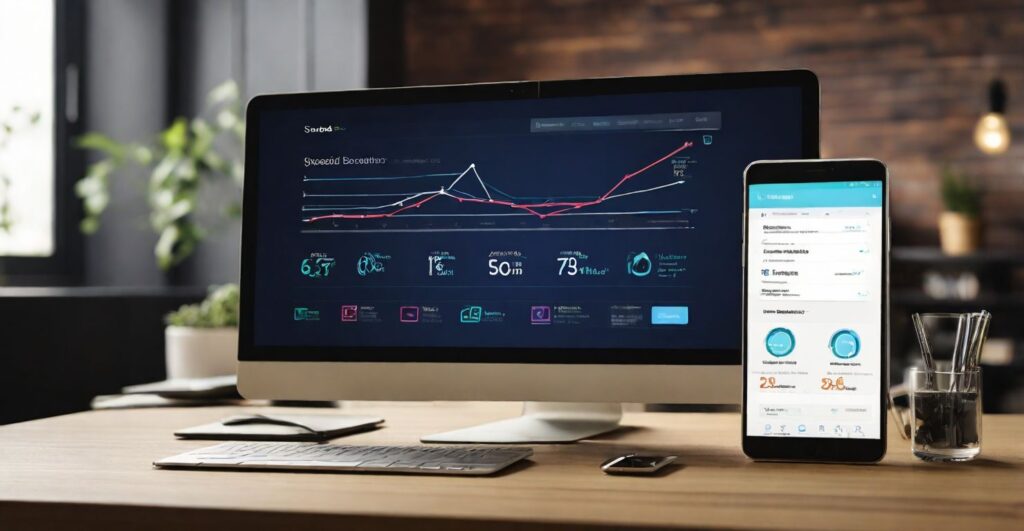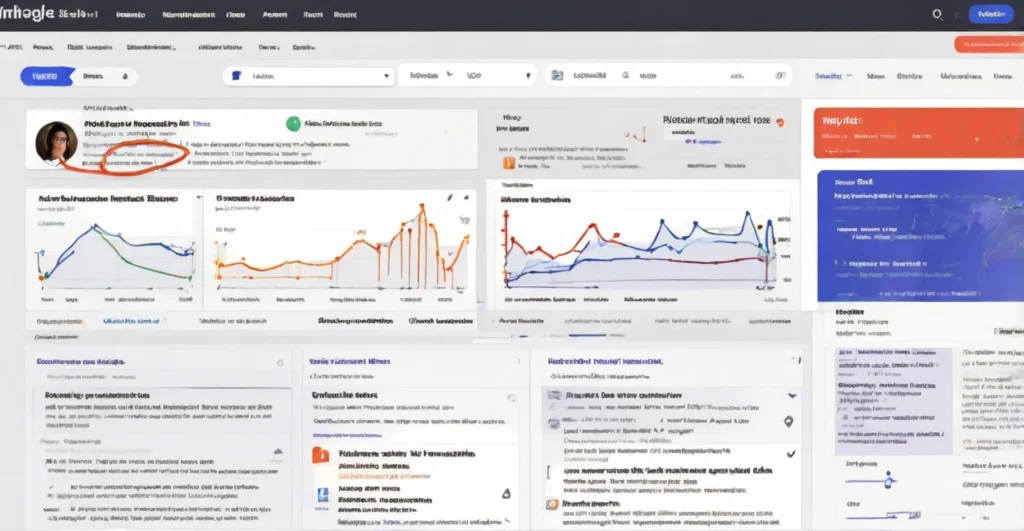Are you finding it tough to get your website seen online? Search engine optimization (SEO) could be the key to more visitors and a stronger online presence. But starting can seem daunting. Don’t worry, we’ve simplified five easy ways to boost your SEO and improve your digital strategy.

Key Takeaways
- Discover practical, easy-to-implement SEO techniques to enhance your website’s visibility
- Learn how to create valuable, search-engine-friendly content that resonates with your target audience
- Optimize your website for mobile devices to provide a seamless user experience
- Leverage keyword opportunities through gap analysis to outrank your competitors
- Leverage SERP features to increase your online visibility and attract more qualified leads
Improve Your Website Loading Speed
In today’s fast digital world, how quickly your website loads is key for SEO success. Fast-loading pages rank higher on Google because users want quick access to content. To make your site load faster, focus on two main areas: making images smaller and making your site mobile-friendly.
Compress Images
Big images can slow down your site. Use tools to make images smaller without losing quality. Tools like Jetpack Boost can help by offloading images, making them load faster. Also, use lazy loading to load images only when they’re needed, which helps with page load time.
Optimize for Mobile Devices
With more people using mobile devices, making sure your site works well on them is key. Use responsive design for a smooth experience on all devices. Reduce HTTP requests, enable browser caching, and use simple URLs to make your site faster on mobile. Tools like Jetpack Boost can help with this.
By making your site load faster and work well on mobile, you’ll improve the user experience. This can lead to better search engine rankings and more visitors to your site.
| Metric | Ideal Value | Impact |
|---|---|---|
| First Contentful Paint (FCP) | Less than 1.8 seconds | Measures the time from when the page starts loading to when any part of the content is rendered on the screen. |
| Largest Contentful Paint (LCP) | Less than 2.5 seconds | Indicates when the main content has loaded and is visible to users. |
| Total Blocking Time (TBT) | Less than 300 milliseconds | Captures the amount of time the main thread is blocked and can’t respond to user inputs. |
| Cumulative Layout Shift (CLS) | Less than 0.1 | Evaluates the visual stability of the site, checking for elements that shift unexpectedly. |
Optimize Your Content for Search Intent
To rank well in search engines, your content must match the search intent behind your keywords. Search intent is the goal or purpose of a user’s search query. It’s important to know if users want information, directions, to buy something, or to take action.
Informational content helps users learn or research a topic. Commercial content is for those looking to buy something. Transactional content aims at users ready to sign up or make a purchase.
- Analyze the top-ranking results for your target keywords to understand what searchers need.
- Use tools like Semrush, Ahrefs, or Sistrix for keyword research that includes intent classification.
- Look at bounce rate and time on page, as low engagement might mean search intent issues.
- Use SERP features like the “People also ask” box and knowledge panel to learn about search intent.
- Check the language in top-ranking title tags and meta descriptions to find intent-driven keywords.
By matching your content with search intent, you make it more relevant and give a better user experience. This leads to higher rankings and more relevant traffic.
5 Simple Ways to Boost Your SEO
Improving your website’s SEO doesn’t have to be hard. There are easy steps you can take to boost your SEO. Let’s look at five simple ways to make your website more visible online and draw in more visitors.
- Publish Authoritative Content: Make content that shows you know your stuff. Make sure your main keywords are in the page URL, title, headings, and text.
- Regularly Update Existing Content: Keep your content fresh. Update old articles to keep them interesting for your readers.
- Build a Link-Worthy Site: Add valuable links to your site. This makes your site better for users and tells search engines your content is valuable.
- Target Keywords with Commercial Intent: Use keywords that show people want to buy something. These keywords can help you get more customers and increase sales.
- Leverage SERP Features: Work on making your content show up in special places on search results pages. This can make you more visible and get more people to visit your site.
Using these easy SEO tips can really help improve your online presence and bring in the right audience for your business. Making great content regularly and optimizing it well are key to doing well in SEO over time.
| SEO Tactic | Impact |
|---|---|
| Implementing 17 SEO techniques | 28.55% organic traffic growth |
| Video embedding | 11.2% improvement in bounce rate |
| Using sitelinks | 14.9% boost in Click-Through-Rate (CTR) |
| Producing linkable content | 3.4x more backlinks received |
| Targeting commercial keywords | CPC of $25.00 for “link building services” |
By using these simple yet effective SEO strategies, you can unlock your website’s full potential. Remember, hard work and focusing on making content that helps users are key to SEO success over time.
Target Keyword Opportunities Through Gap Analysis
Doing a keyword gap analysis can reveal keywords your competitors use but you don’t. These are keywords that can help you reach more people online. By finding these “missed opportunities,” you can grow your online presence and draw in new visitors.
Use Semrush’s Keyword Gap Tool
Semrush’s Keyword Gap tool simplifies this task. It lets you compare your site with up to four competitors to find keywords they rank for but you don’t. You’ll get a detailed list of these keywords, including their search volume, competition level, and potential organic traffic.
By focusing on these gaps, you can make content that answers the questions your audience is asking. This can greatly increase your organic traffic and help you take a bigger share of the market.
| Metric | Description | Importance |
|---|---|---|
| Organic Traffic | The amount of website visitors coming from search engines through unpaid, or “organic,” results. | A key indicator of the success of your keyword gap analysis strategy. |
| Exit Rate | The percentage of visitors who leave your website from a specific page. | Helps identify low-performing pages that need SEO and content improvements. |
| Click-Through Rate (CTR) | The ratio of users who click on a search result to the total number of users who view that result. | Reflects the effectiveness of your SEO-friendly titles, meta descriptions, and URLs in attracting visitors. |
| Pages per Session | The average number of pages a visitor views during a session on your website. | Indicates the user-friendliness and quality of content on your website. |
| Top Keywords Ranked | The specific keywords your website ranks highly for in search engine results. | Tracking these can help you create trending content and improve search engine rankings. |
Using the insights from a keyword gap analysis, you can spot and use your competitors’ missed chances. This can bring more qualified traffic to your site and boost your SEO performance.
Leverage SERP Features for Increased Visibility

In today’s digital world, it’s key to make your content stand out by using SERP features like featured snippets, sitelinks, and video results. These can greatly increase your online visibility and bring more visitors to your site.
Featured snippets, also known as “position zero,” give a quick answer to a search question right at the top. This spot lets you show your expertise and grab users’ attention before they visit your site. Use “Snippet Bait” to increase your chances of being featured in this top spot.
Sitelinks can also boost your organic CTR by taking up more space on the search page. These links to your site’s main pages help users find what they need faster, making their visit better and helping your site get noticed more.
Video results are another way to stand out online. By making your videos search-friendly, you could see them in the video carousel or as a standalone result. This is great for businesses like e-commerce, where showing products or how to use them can really help customers decide.
To make the most of these SERP features, know your industry, audience, and what they’re looking for. Look at SERP data to see which features are most common and which fit your goals. By optimizing your content and using these powerful SERP features, you can get more people to visit your site.
| SERP Feature | Description | Benefits |
|---|---|---|
| Featured Snippets | Concise, direct answers to search queries displayed at the top of the SERP. | Increased visibility, higher click-through rates, and positioning as an authority in your industry. |
| Sitelinks | Additional links to your website’s key pages displayed below your main listing in the SERP. | Improved navigation, increased organic CTR, and enhanced brand presence. |
| Video Results | Video content displayed as a standalone result or within a carousel in the SERP. | Increased engagement, better user experience, and potential for higher conversions. |
Conclusion
Using these simple yet effective SEO best practices can really help your website show up more in search results. Improving your site’s speed and making content match search intent are key steps. Also, doing keyword gap analysis and using SERP features can make a big difference in your SEO performance.
Creating content that matters to users and fixing your website’s technical issues can bring in more targeted visitors. This helps make your brand a trusted source. A good SEO plan should include making content better, improving your site, and building links wisely. This mix is essential for growing your online presence over time.
Always keep an eye on how you’re doing and be ready to change your strategy as search engines change. With hard work and using data to guide you, SEO can help you boost your online success.
FAQ
What are the key factors to improve website loading speed for better SEO?
Compressing images and making them web-friendly is key. Also, having a design that works well on mobiles is crucial. Don’t forget about technical SEO tips like reducing HTTP requests and using browser caching. A clean URL structure also helps.
How can I create content that aligns with search intent to improve rankings?
First, figure out what kind of content people are looking for. This could be info, directions, shopping, or buying something. Then, make your pages match what people need. Look at top results for your keywords to see what works best.
What are the simple ways to boost my website’s SEO performance?
Start by making high-quality, informative content with the right keywords. Keep your content fresh and update it often. Make your site a place people want to link to. Target keywords that show people are ready to buy something. Use special SERP features like sitelinks and videos to get noticed.
How can I identify untapped keyword opportunities for my website?
Use tools like Semrush’s Keyword Gap tool for a keyword gap analysis. This lets you see which keywords your competitors rank for but you don’t. This can show you where to improve.
How can I optimize my content to appear in valuable SERP features?
Try using “Snippet Bait” to get your content in the featured snippet box. Also, work on showing up in sitelinks and video results. These can help more people click on your site.
